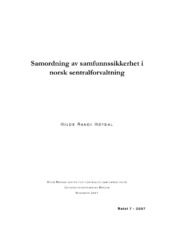| dc.contributor.author | Høydal, Hilde Randi | eng |
| dc.date.accessioned | 2007-12-10T13:44:00Z | |
| dc.date.accessioned | 2020-12-10T06:31:43Z | |
| dc.date.available | 2007-12-10T13:44:00Z | |
| dc.date.available | 2020-12-10T06:31:43Z | |
| dc.date.issued | 2007-11 | eng |
| dc.identifier.issn | 1503-0946 | |
| dc.identifier.uri | https://hdl.handle.net/1956/2486 | |
| dc.description.abstract | This paper is based on a study of the development of the internal security in the Norwegian Central Government in the period from 1994 to 2007. The main focus in the paper is on the roles which the Ministry of Justice and the Directorate of Civil Protection and Emergency Planning (DCE) holds. The aim is to study the vertical coordination between these, and the horizontal coordination between DCE and the sectoral ministries. The reason for the changes and the need for a superior coordinator was that the field of civil security was described as fragmented and not well organized. In the period from 1994 to 2005 three Royal decrees, which were all important for the policy changes came. These have led to strengthening the coordination role of the Ministry of Justice and a more evident supervisory role for the DCE. The process with getting the decrees approved was characterized by the sector departments fear that the constitutional responsibility and the principles of responsibility, subsidiarity and similarity, would be weakened by giving the Ministry of Justice a stronger role of coordination, and by giving DCE the supervisory role. The policy-changes have had an impact on the practice. The most important change in practice is supervision with the sector ministries internal security work. By supervising, DCE gets the present status, which is important for the Ministry of Justices horizontal coordination responsibility. The Ministry of Oil and Energy, and the Ministry of Culture- and Church are used as cases in this study to illustrate the supervision in practice. The study shows, among other things, that the supervisions of the DCE are characterized by soft means such as advice and guidance, and a lack of strong means. This kind of supervision has been well received and has led to increased awareness about internal security in the sectoral ministries. The study also shows that the weak sides are in the follow-ups done by the Ministry of Justices and the weak connection in civil security work between the sectoral ministries and the underlying departments. | en_US |
| dc.description.abstract | Dette notatet er basert på en studie av utviklingen av beredskaps- og samfunnssikkerhetsområdet i norsk sentralforvaltning fra 1994 og fram til i dag. Fokuset er rettet mot Justisdepartementet og Direktorat for samfunnssikkerhet og beredskap (DSB) sine roller. Målet er blant annet å studere den vertikale samordningen mellom disse to, og den horisontale samordningen mellom DSB og fagdepartementene. Et fragmentert samfunnssikkerhetsfelt har vært bakgrunn for endringer og ønske om en overordnet koordinator på feltet. Fra 1994 til 2005 har det kommet tre resolusjoner som har vært viktige for policyendringer på dette området. Disse har bl.a. ført til at Justisdepartementet sin samordningsrolle har blitt forsterket og at DSB har fått en tydelig tilsynsrolle. Prosessen med resolusjonene var preget av motstand fra fagdepartementene, der begrunnelsen var frykt for at det konstitusjonelle ansvaret, og prinsippene om ansvar, nærhet og likhet ville bli svekket ved at Justisdepartementet fikk styrket sin samordningsrolle og ved at DSB fikk tilsynsansvar for sektoren. Endringene i policy har resultert i endring i praksis, der tilsyn med departementenes beredskapsarbeid er en av de viktigste. DSB skal gjennom tilsynene fremskaffe en oversikt over status på beredskapsarbeidet i departementene, slik at Justisdepartementet får utøvd sitt samordningsansvar. Olje- og energidepartementet og Kultur- og kirkedepartementet sine tilsynsrapporter og erfaringer med tilsyn, er valgt ut som case i studien for på denne måten å bedre illustrere tilsynsutøvelsen i praksis. Studien viser bl.a. at DSB sine tilsyn er preget av myke virkemidler som råd og veiledning, og at det er mangel på sterke virkemidler i tilsynsarbeidet. Denne formen for tilsyn har blitt godt mottatt og ført til økt bevisstgjøring i departementene. Studien viser også at de svake punktene ligger i Justisdepartementets oppfølging og at det er en svak kobling til samfunnssikkerhetsarbeidet i underliggende etater. | no |
| dc.language.iso | nob | eng |
| dc.publisher | Stein Rokkan Centre for Social Studies | eng |
| dc.relation.ispartofseries | 7-2007 | |
| dc.relation.ispartofseries | Notat | no |
| dc.title | Samordning av samfunnssikkerhet i norsk sentralforvaltning | nob |
| dc.type | Working paper | eng |
| dc.subject.nsi | VDP::Samfunnsvitenskap: 200 | nob |
